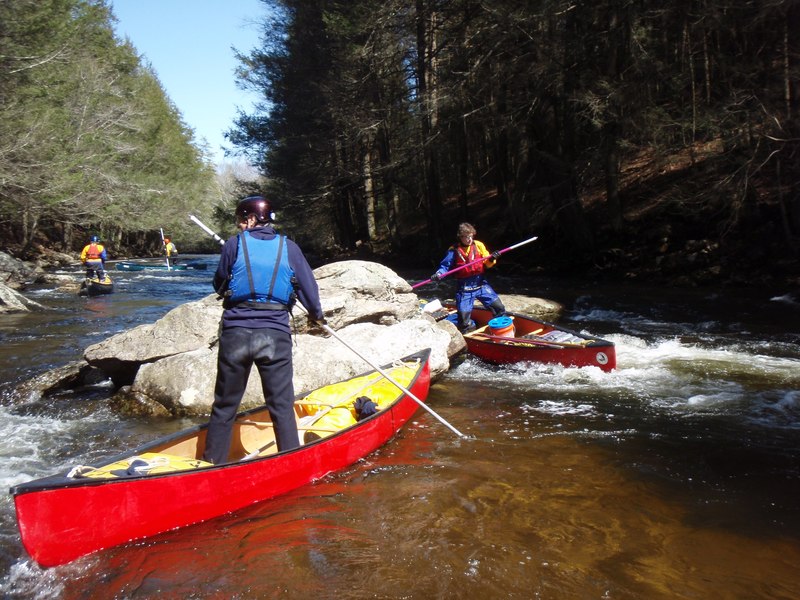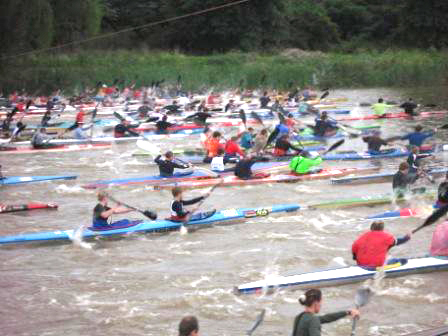Where’s My Story?
Here’s a new report on the fun sport of flatwater fast canoe poling. I had written it up years ago when I first discovered it but the link got lost on my webiste, due to malfunction. I just found it in my Backlist of old boating articles and reposted it, bumping it up to yesterday, for your amusement. Here’s the direct link: outyourbackdoor.com/article.php?id=1597. It probably duplicates most of what follows but whatever. I had to write up my latest take on the sport.
Of course, the latest action is in an even-newer post where I put up some pics and videos I finally did of poling and standup canoe paddling.
By the way, if you want to see more old OYB Boat stories here’s the link to em: outyourbackdoor.com/section.boats.html.
Here’s My Same Old Story Again, Basically…
In short, my article says that for shallow water a canoe pole is just as good a way to get around in a canoe as is a paddle. And in some ways it’s MUCH better.
I like it so much that I hesitate to sit down. It seems totally natural. Not really any tippier than regular paddling — but you do need to be a little nimble if you want to get friskier than usual.
Now, shallow water can be slow for paddling. It’s called “suckwater.” But it’s great for poling.
What it’s like…
When poling, you get a great view into the water because you’re looking down into the water from overhead rather than at an angle. I’d say you see the bottom and features of the river about 3 times as good as when sitting. It’s wonderful to see so many more fish!
And you get a far better view of the terrain both down the river (or up) and beyond the riverbanks. It’s like going for a walk in terms of your posture. Your horizon is extended manyfold by standing as compared to sitting. And in terms of view
Also, you can go darn fast and get in a great all-body workout. It’s very dyno — you rise up, plant the pole then throw you whole weight onto it and shoot forward with your weight transfering from the pole to your forward foot. You can turn the canoe by carving or edging it, just like you’re riding a snowboard or surfboard.
Of course, SUP (stand-up) paddling in a canoe is just as fun. Except that with poling you get PURCHASE on the bottom, which gives a LOT of stability. SUP is done in deeper water. Your stability then has to be internal. It’s like the difference between groomed and powder skiing. When I go out paddling these days, I always bring my pole, my SUP paddle and a regular paddle. The shorty hardly gets used.
SUP canoeing doesn’t seem to have caught on elsewhere yet. At least it hasn’t hit the media. (I’ve put up a few posts.) What should this new sport be called, anyway? I suppose it has to be SUC. Or, maybe since it would also work with a stable kayak with a big cockpit, it should be SUC&K… !!! Check it out, it’s the big new thing!
What’s funny is that as I was discovering this stuff on my own, I’d occasionally bump into my local old fart pal George Stockman. Every time he’d say “Oh yeah, I’ve been doing that around here for years! My back is bad so that’s what I do…” He beats me to everything just coz he’s injured. That George! So he had a long paddle before I did (or ANYONE else, I bet! Except maybe Laird Hamilton). But my paddle is LONGER. I like a 6’6″ length of SUP. He says he likes em shorter for whitewater. But that’s not my scene. Nor his, if he does it around here. But George has done everything, actually. He’s been open-canoe national champ in various modes (solo, tandem). He’s done the AuSable Marathon in a C1 (after the racers took off, or maybe before). And he XC skis, too! …When his back lets him.
Getting wet…
If you ever do wipe out — and you just might your first few times out — it’s actually much easier on you than when you’re sitting. You usually just step out of the boat into the shallow water. If you fall out, it’s more of a stumble but you can usually easily catch yourself with a step into the water. I rarely get wet above my calf. Ya gotta watch that you don’t bang your shin on the gunnel when stepping out, but whatever: it’s usually a moderate experience. And you tend to leave the boat empty and upright — but that’s also what usually happens when falling out while sitting. Boats are good at staying up, it’s the people who have trouble.
In fact, I often intentionally just step out of the boat and walk it by the bow painter, if being out of the boat is handier for you. You can so easily get in and out of the boat now, so you do it more often. It’s far easier to deal with obstacles or overly shallow sections. Just lead your boat thru it like it was a dog. It’s so cool to have being out of the boat be such a viable option.
Now, river water tends to be warmer than you think, too. I find that it’s fine for wading even in Michigan November — for a good month of cold weather the water is warmer than the air and feels fine on the tootsies.
Speed!
Lastly, you can do this in a fast canoe. I use an old race boat most times. It’s so fast! It’s just as fast as race paddling, up or downstream. I haven’t tried it in the newest tippiest boats, but whatever, I’m sure it’d work. I’ve timed myself and for 45 minutes up or down the river poling is on par with race-paced paddling.
What to Bring for Max Boat Fun…
What I do, in the end, is this: I bring a paddle, a long SUP paddle for deep water, and my 12-foot aluminum two-part canoe pole. Then I’m ready for anything! Each item stashes easily into my old 1982 Wenonah Advantage kevlar boat.
Hey, I haven’t even mentioned, really, what a canoe pole is! Mine is 12 feet, yes. But you can whittle your own out of a sapling. You can use them in a couple different ways, too. You can change from end to end as you push on each side. Or you can change sides like you do with a paddle. With a homemade sapling or when you want to keep your hands drier then you tend to just switch sides. But the “windmilling” style is dandy, too. Find out for yourself what length you like best. My 12′ alum is perfect, but I’ve had a great time with other lengths. With a long pole you can push for a couple hand-over-hands.
A Little How-to
And I also haven’t really talked about HOW to do it. Now, there are a couple books about it, but they tend to present poling in terms of tricky whitewater work. My flatwater angle seems to be a unique presentation — yet flatwater is what we have the most of in Michigan. Garrett Conover has his hard to find “Beyond the Paddle,” a book about poling and lining for expeditions. Harry Rock is much more active. He has a DVD, at least one YouTube and at least two books, one of which includes competition poling — he’s the endless champ and he organizes the annual championships. We should duke it out sometime! Whups, there’s actually quite a bit of canoe poling online out there! I gotta look into this more. It wasn’t out there when I posted my first canoe poling article!
Anyway, I think it’s natural enough that you can just figure it out. I tend to do it with my feet like on a snowboard, but others do it with feet side-by-side. I often hit things so I want to be ready to absorb shock yet stay in balance. I put a section of plumber’s foam around the thwart that goes behind the seat of my canoe — I often push my shin up into that for more support. I got a couple bruises from it before padding it.
I find that I have to fool around with where I stand and how I pole to get the boat to run straight. Sometimes I tilt the boat a bit. But basically, if you pole straight back it goes straight forward. I sometimes get a little “hang-time” as with XC ski poling — it’s when I’m done poling and follow-thru with my hands and ride out with my weight on my front foot. Sometimes my other foot comes off the bottom and I’m just gliding along on one foot with the pole out of the water behind. Oh yeah!
Speaking of glide, if you stand in the middle you get the most waterline wetted — that gives most speed. That’s why I like to glide on the forward foot — I have the boat most evenly weighted fore-aft in that way. Totally dyno, man!
Hey, when you get into deep water, just use the pole like a paddle. It gets plenty of purchase just pulling it thru the water (think of a Greenland paddle). And you can windmill it like a kayak paddle.
See my newer posts for pics and videos!
Related Media…
When I posted my first article, there was NUTTIN’ online about polin’, much less standup canoe paddling. But now there are a bunch of forum discussions and videos showing canoe poling.
Here’s a YouTube showing the wide range of skills involved. I note that shallow-water speed-glide poling doesn’t seem to be included…
www.youtube.com/watch?v=GxAZ9ApDsM4&feature=related
Here’s a discussion which includes a long and detailed “how to” post from an official Maine Guide ™: www.adventurecanoe.com/forum/topic/canoe-poling-a-lost-art
Here’s a nice long chat:
www.solotripping.com/community/showthread.php?t=2326&page=3
Too bad my articles haven’t been searchable for a couple years now. I think they woulda been handy and gotten a lot of hits. …I still see no mention of the speed potential for fast flatwater action. It’s almost all the robust whitewater oriented stuff. Well, maybe this new item will get some hits and some response…
I can’t find a place that sells the superduper aluminum pole, but there’s info on making your own. Here’s a guy who sells a poling foot: nwwoodsman.com/
Here’s info on the Competition and Event scene, with links to pics: polecanoe.angelfire.com/canoepole.htm
Speaking of pics, see mine in my other article, but here’s also a good one from the link above…



